Prelude to Disaster
The 1800’s was a time of great invention, westward migration, the American Civil War, industrial expansion and it also was a time of recklessness which all too often led to catastrophe. Such was the case in Hinckley Minnesota in the year 1894.
Thank you for reading this post, don't forget to subscribe!Pine County Minnesota was going through a tremendous drought in 1894. In fact, it hadn’t rained for months and compounding the extreme dryness were soaring temperatures. People of the area hadn’t remembered a time that it was so dry. Summer fires in the forests were nothing that uncommon.
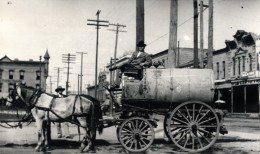
Somewhat common were small fires set off from the sparks of passing locomotives and there was an abundance of locomotives in the late 1800’s. Railroads stretched throughout the state. Hinckley was fortunate enough to be the crossroads to several rail lines. The main line ran south from Duluth to St. Paul. Plenty of passengers were heading in both directions. Hinckley was a town where many people were traveling to.
The logging industry in and around Hinckley meant everything to the economy. The pine forests of Minnesota were a bonanza for the logging industry after many of the eastern forests were depleted. The logging industry kept heading west. Sawmills in the area were operating at full capacity and the jobs were plentiful for immigrants arriving in America looking for a fresh start. Hinckley, although small, was a classic example of a town created from one burgeoning industry. During all of this building and the subsequent increase in population the one thing that may not have been addressed was the real possibility of fire a devastating fire.
Everything looked good for Hinckley Minnesota. The population was growing, people were building houses and the jobs were plentiful. What happened to Hinckley happened to other towns and cities who were in an around about way a victim of what was endemic during the latter 1800’s in America...an absence of federal regulation and oversight.
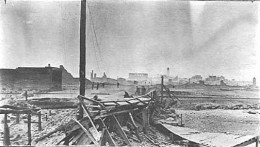
While the trees were felled at a dizzying pace forest management practices were nonexistent. Limbs, sawdust and a combination of wooded debris was simply left on the forest floor. The loggers were after the big trees not the small stuff. Trees that were cut down were quickly hauled to the nearest stream and floated down river to the sawmills. Cleaning up after the cutting was never a thought. When trees were felled and there was still daylight, you simply moved on to the next stand. Forest management, while being discussed and debated both here and in Europe, was just that…a debate, although several European countries were starting to practice wise forest management.
Like most disasters, there usually are several contributing causes and sometimes the added danger of a sheer lack of disaster preparedness. One cause alone usually isn’t enough. In Hinckley’s case, the summer of 1894 was a time that would bring together all the necessary elements to form a catastrophic firestorm.
The Disaster Unfolds
While the summer of 1894 was a particularly brutal one for Hinckley Minnesota, the extent of the problem really was not fully understood. Disaster preparedness probably wasn’t on the top of peoples minds. The possibility of a firestorm, let alone the understanding of what a fire storm was, didn’t seem to rattle the populace. The weather service of the U.S. government was in it’s infancy. Weather forecasting in 1894 was essentially a telegraph message of what conditions were like at some point further west or southwest. You could call a forecast in 1894 purely conjecture however most believed it to be better than no forecast at all. What was on peoples minds in Hinckley was the need for rain, not really a fear of a firestorm. Why there wasn’t some type of evacuation under way before the conflagration occurred will never be known. After all, fire as a disaster was nothing new. It happened years earlier in Peshtigo Wisconsin. The Peshtigo fire occurred on the same day as the Great Chicago Fire in 1871.
Two additional articles on our Western Trips site you’ll find interesting are the Great Fire of 1910 and the Beginnning of the Forest Service and the Smokejumpers.
An Unusually Hot and Dry Summer
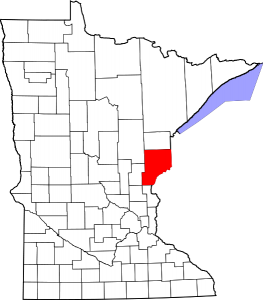
As the dry and hot summer progressed in Pine County Minnesota, what became apparent was that the debris on the forest floors would dry out to such an extent that it would actually smolder. The forest floors would begin smoking as a result of extreme dryness coming in contact with hundred degree temperatures. In a way it’s almost like a ticking time bomb which only an adequate rainstorm could stop. Certainly there was concern but probably what wasn’t realized at the time were the consequences. This was all a prelude to the Hinckley fire.
Finally. on September 1st 1894, after months of no rain, the conflagration began. The forests erupted in flames from several directions at once. To the people in Hinckley it was a smoldering fire which had covered the town with smoke and a haze for days that suddenly erupted into spontaneous combustion, almost like an explosion. It was spontaneous combustion in several places at once. There were efforts to fight the flames and try to save town structures however it soon became apparent that it was a losing battle. This of course was before smokejumpers, water tanker aircraft and hot shot crews. The town of Hinckley had a fire wagon loaded with water along with shovels and pick axes to try to dig fire breaks…all quite inadequate to fight this type fire. It was a firestorm, not a mere fire. It had a mind of it’s own. The Hinckley fire was beyond anyone’s control.
When fires of the size Pine County experienced grew, they spawned their own weather. This happened during the Great Hinckley Fire of 1894.
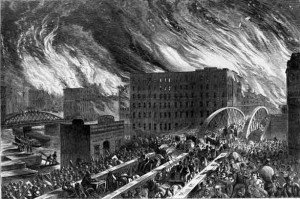
The fire became a firestorm with vortexes and actual tornadoes forming from the high winds created by the fire itself. The science of the firestorm is fully understood today, but in the 1890’s it was not. Escaping a firestorm like this was extremely difficult. The fire storm created updrafts which caused strong gusts of wind which only increased the flames and made the conflagration spread at an enormous speed. Again, there were attempts to fight the flames that tore into the wooden structures. Wooden structures in a town like Hinckley were the norm. After all, wood was plentiful in Hinckley. The flames simply overwhelmed the fire crews and the only option was to try to escape. That was not easy. Many fled to the train depot to try to hop a train. Others ran to the river and attempted to hide underwater frequently coming up for air. Some others put their worldly belongings on wagons and tried to get out of town. The Hinckley evacuation was essentially mass hysteria. Even the train was caught in the flames and many didn’t make it out by that means. According to news stories of the time, people looked for shelter everywhere including wells and a railroad gravel pit. For many, evacuation simply was impossible.
According to the Minnesota Historical Society records, the fire raced across 480 square miles and burned 350,000 acres. An enormous area to be burned in only a matter of hours. The death toll was estimated at 400.
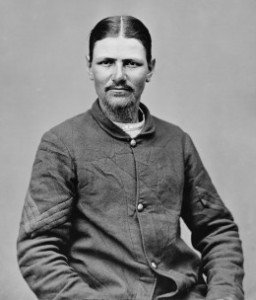
The Story of Boston Corbett
Who would have thought that Thomas P. “Boston” Corbett would end up in Minnesota? This is the Boston Corbett who in 1865, some twenty-nine years before the Great Hinckley Firestorm, was a soldier in the Union Army.
Corbett was with a cavalry group hot on the trail after John Wilkes Booth, just days after the assassination of President Abraham Lincoln. Booth had fled with a companion through the southern Maryland swamps and across the Potomac River into Virginia. Boston Corbettt was a member of the 16th New York Cavalry Regiment.
This regiment was dispatched to locate and arrest John Wilkes Booth, the assassin of Lincoln. Booth was at large but the noose was tightening. On April 26th, the regiment which was transported down into Virginia by steamer surrounded Booth and his accomplice, David Herold, in a barn at Garrett’s Farm just south of Port Royale Virginia. Herold surrendered and left the barn. Booth remained inside. After Booth refused to surrender the barn was set on fire. The intent was to force Booth out, not kill him. Boston Corbett was standing near a large crack in the barn wall. Corbett saw Booth through the crack, aimed his Colt revolver and shot him. The shooting by Corbett was strictly against orders. Secretary of War Stanton had wanted Booth taken alive. As a result, the commander of the regiment placed Corbett under arrest.
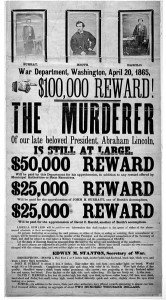 Booth died hours after the shooting and his body, along with the cavalry regiment, was transported back to Washington D.C. via steamer. Incredibly, and aside from the fact that Corbett disobeyed direct orders, he was awarded a handsome bonus for his action of over $1,600. This apparently was his share of the total reward money.
Booth died hours after the shooting and his body, along with the cavalry regiment, was transported back to Washington D.C. via steamer. Incredibly, and aside from the fact that Corbett disobeyed direct orders, he was awarded a handsome bonus for his action of over $1,600. This apparently was his share of the total reward money.
Years of Running
Corbett left the military later in 1865 and worked as a hatter in the northeast. Eventually, Corbett moved to Kansas and his behavior became quite odd and at times violent. Was this the “mad hatter” syndrome where mercury used in felt hats caused insanity? This indeed was what many thought during the 1800’s. We do know that mercury poisoning can be fatal. As far as whether or not it can lead to insanity, no research I have seen either proves or disproves it.
While working as a doorman at the Kansas State Assembly, Boston Corbett pulled out a pistol and threatened people. This got him a one way ticket to an insane asylum. He escaped from the asylum and at first was planning on fleeing to Mexico but changed his mind. Instead, he ended up living in a cabin in the woods outside of Hinckley Minnesota. This was during the years of 1888-89, just in time to settle in a growing lumber town far away from big cities.
Engulfed By Two Fatal Events
While precise records concerning Corbett’s movements in those years is a bit sketchy, what is known is that he was living outside Hinckley, in the forest, when the firestorm occurred. After the Great Fire Corbett was gone, never to be seen or heard from again. What apparently remained at the site where the cabin was located was simply a dug out hole.
Based on this and the massive loss of life during the Great Fire of Hinckley, it was presumed that Boston Corbett fell victim to the catastrophe. Thomas P. “Boston” Corbett ironically came to be a well known individual as a direct result of one of the most infamous events during the 19th century, the assassination of President Abraham Lincoln. It’s believed he left this world during another catastrophic 19th century event, the Great Hinckley Firestorm. At the time of his presumed death, Boston Corbett would have been 62 years old.
Fire Museums in Hinckley and Peshtigo
Today there are two fire museums which chronicle the devastating firestorms in both Hinckley and Peshtigo Minnesota. The Hinckley Fire Museum is located at 106 Old Highway 61 Hinckley, MN. The Hinckley museum tells the story of what happened and the stories of the survivors and those who didn’t survive this epic firestorm. The Peshtigo Fire Museum is located at 400 Oconto Avenue, Peshtigo, WI.
(Photos and images from the public domain)
